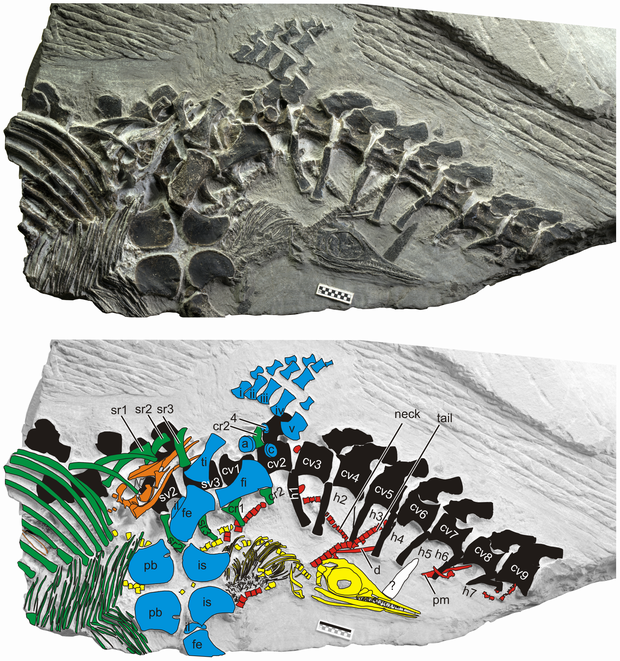Fossilization is rare. It may seem common to find them because there have been billions of years and an entire planet on which to do it, but things really have to go right. An ancient fossil caught in the act of giving birth is bordering on spectacular.
We often think of evolution as moving from water to land, Ichthyosaurs were giant marine reptiles that evolved from land reptiles and moved to water. Scientists have reported a new fossil specimen that belongs to Chaohusaurus (Reptilia, Ichthyopterygia), the oldest of Mesozoic marine reptiles that lived approximately 248 million years ago.
What is truly impressive is that this Ichthyosaur fossil, a partial skeleton recovered in China, may show a live birth - the earliest live birth from an ancient Mesozoic marine reptile.

Chaohusaurus specimen with three embryos. Color coding indicates: black, maternal vertebral column, including neural and haemal spines; blue, maternal pelvis and hind flipper; green, maternal ribs and gastralia. Embryos 1 and 2 are in orange and yellow, respectively, whereas neonate 1 is in red. Scale bar is 1 cm. Abbreviations: i-v, metatarsals; 4, fourth distal tarsal; a, astragalus; c, calcaneum; cr, caudal rib; cv, caudal vertebra; d, dentary; fe, femur; fi, fibula; h, haemal spine; il, ilium; is, ischium; pb, pubis; pm, premaxilla; sr, sacral rib; sv, sacral vertebra; and ti, tibia. See fig. S2 for a high resolution image.. Credit: Ryosuke Motani, doi:10.1371/journal.pone.0088640
The maternal skeleton was associated with three embryos and neonates: one inside the mother, another exiting the pelvis-with half the body still inside the mother-and the third outside of the mother. The headfirst birth posture of the second embryo indicates that live births in ichthyosaurs may have taken place on land, instead of in the water, as some studies have previously suggested.
The new specimen may contain the oldest fossil embryos of Mesozoic marine reptile, about 10 million years older than those indicated on previous records. The authors also suggest that live births in land reptiles may have appeared much earlier than previously thought.
Dr. Ryosuke Motani from the University of California, Davis, said, "The study reports the oldest vertebrate fossil to capture the 'moment' of live-birth, with a baby emerging from the pelvis of its mother. The 248-million-year old fossil of an ichthyosaur suggests that live-bearing evolved on land and not in the sea."





Comments